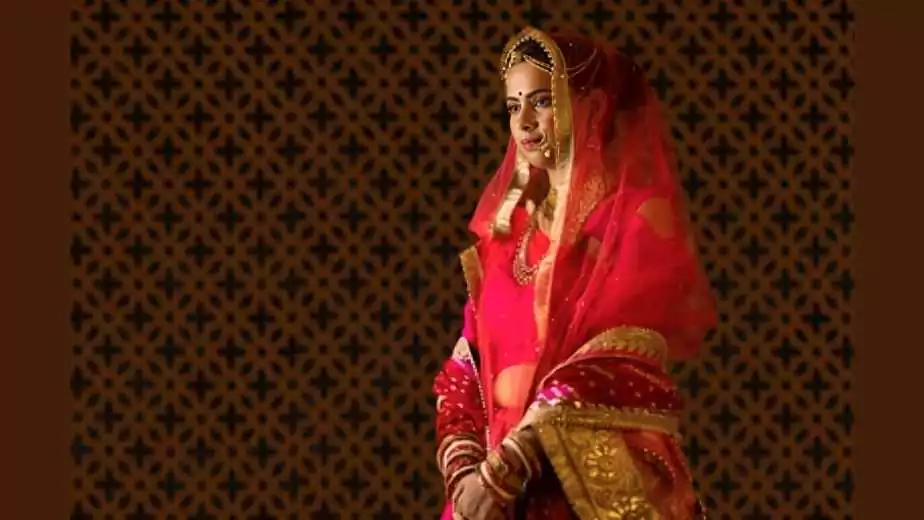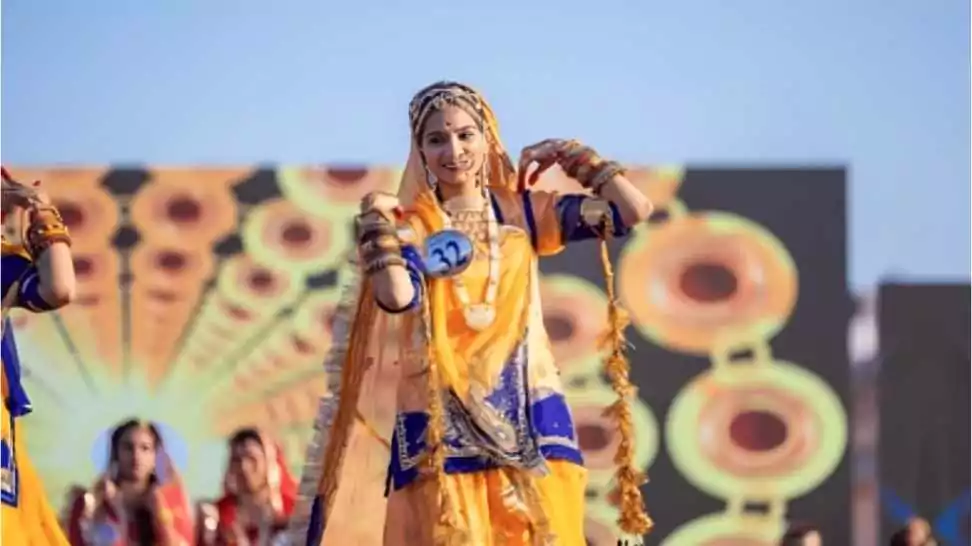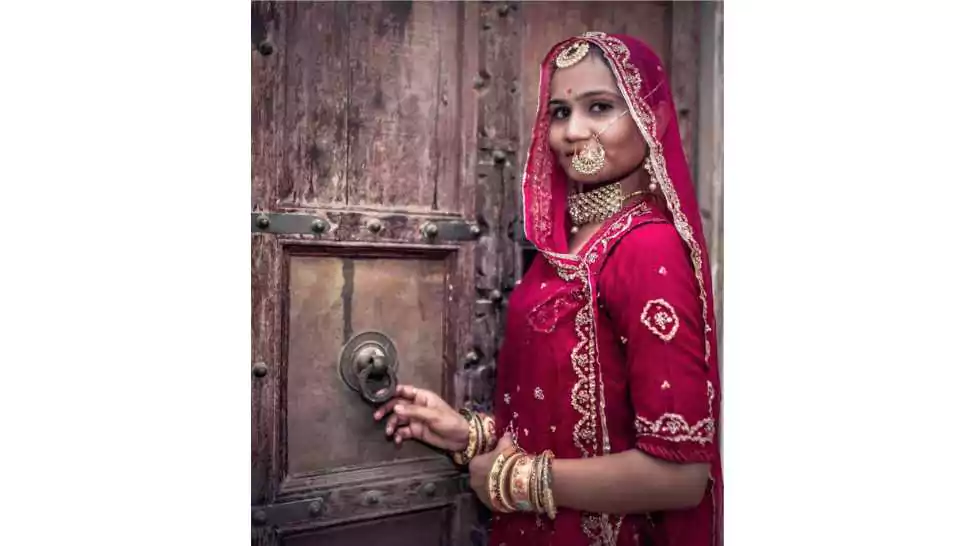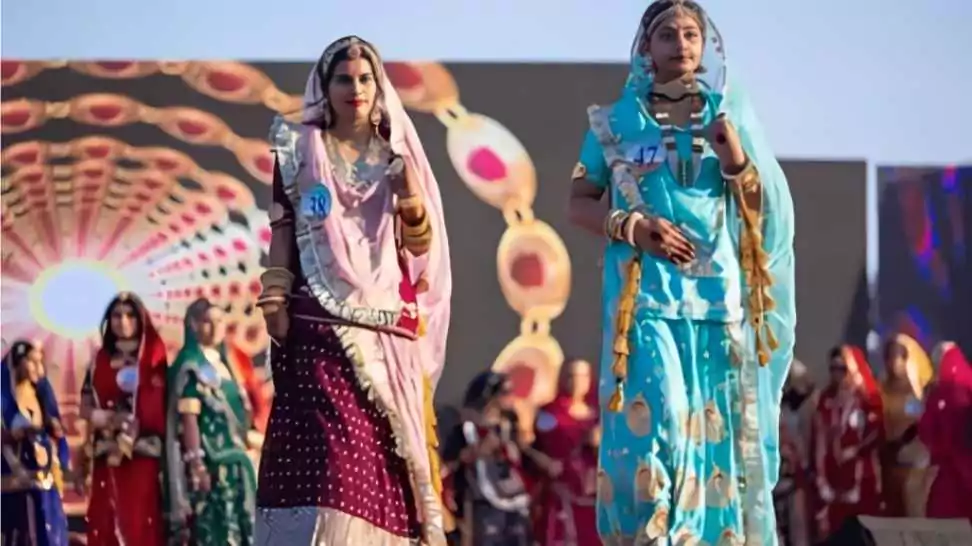How To Wear Rajputi Poshak? Step-by-Step

In the rich tapestry of Indian cultural attire, the Rajputi Poshak holds a place of pride and elegance. This traditional attire, deeply rooted in the Rajputana heritage of India, is not just a piece of clothing but a symbol of grace, honour, and the regal legacy of the Rajput community. The Rajputi Poshak is a celebration of the rich history, vibrant culture, and the indomitable spirit of the Rajput women, seamlessly blending the past with the present.
This guide takes you on a detailed journey into how to wear Rajputi Poshak. We delve into the intricate process of draping this traditional attire, highlighting each component – from the saree to the dupatta, odhni, chunni, and the quintessential Rajputi jewellery that complements the ensemble. Whether you are new to this attire or looking to refine your skills in draping and accessorizing, this guide aims to provide you with comprehensive insights into mastering the elegance of the Rajputi Poshak.
1 The Essence of Rajputi Poshak

The Rajputi Poshak, more than just a traditional attire, is a living narrative of the Rajput culture’s grandeur and dignity. Its origins trace back to the royal courts of Rajputana, an era that celebrated valour, chivalry, and opulence. The Poshak, worn by the women of the Rajput clans, was a symbol of their status, pride, and heritage. It served as a sartorial emblem of their unyielding spirit and the rich cultural tapestry of the Rajputs.
Historical Background and Importance in Rajput Culture
Rajputi Poshak is steeped in history, each thread woven with stories of the past. In the royal courts, these attires were more than just garments; they were a testament to the Rajput’s aesthetic sensibilities and their commitment to preserving their culture through centuries. The colours, designs, and fabrics used in Poshak were often indicative of one’s role, status, and occasion, making it a vital part of Rajput’s social and cultural identity.
Today, the Rajputi Poshak continues to be a cherished heirloom in Rajput households, passed down through generations, symbolising the unwavering pride and the enduring legacy of the Rajputana customs and traditions.
Key Components of Rajputi Poshak
The Rajputi Poshak consists of several key elements, each with its significance and style:
- The Saree (Lehenga): Typically, the base of the Poshak is a saree or a lehenga, crafted from rich fabrics like silk, chiffon, or georgette, adorned with intricate patterns and vibrant colours. The saree or lehenga represents the elegance and grace of the Rajputi style.
- The Kurti and Kanchli: These are the upper garments worn with the saree. The kurti is a waist-length blouse, while the kanchli, a shorter blouse, is worn over the kurti, both usually elaborately embroidered and embellished.
- The Odhni (Dupatta): An essential component, the Odhni, is a long, flowing piece of cloth that is draped over the head and the shoulder, symbolising respect and modesty. The art of draping the Odhni is unique to the Rajputi Poshak and is a skill passed down through generations.
- The Chunni: Often used as an additional layer of draping, the Chunni adds a layer of sophistication and complexity to the ensemble.
- Accessories and Jewellery: Rajputi jewellery is as significant as the Poshak itself. Traditional pieces like the Rakhdi (headpiece), Bajuband (armlets), and heavy necklaces are integral to completing the look, each piece reflecting the opulence of Rajput jewellery craftsmanship.
2 How to Wear Rajputi Saree?
The Rajputi saree, with its rich fabrics and intricate details, is a testament to the traditional craftsmanship and elegance of Rajput culture. Wearing it is an art, combining the grace of the past with the nuances of modern style. Here’s a step-by-step guide to draping a Rajputi saree, along with tips to ensure a traditional look that also accommodates contemporary tastes.
Step-by-Step Instructions
- Starting with the Basics: Begin by wearing the petticoat and blouse (kurti and kanchli). Ensure they are well-fitted and comfortable.
- Draping the Saree: Hold the saree end (the plain end, not the pallu) and start tucking it into the petticoat from the right side of the waist. Continue tucking as you go around.
- Making the Pleats: Once you come back to the starting point, make about 5-7 pleats of equal width. Hold them together so that they fall straight and neat.
- Securing the Pleats: Tuck the pleats into the petticoat at the waist, slightly towards the left side, ensuring they open towards the right.
- Draping the Pallu: Bring the remaining fabric around from the left side and drape it over the right shoulder. The pallu should fall gracefully, and its length can be adjusted as per preference.
- Final Adjustments: Adjust the pleats and the pallu to ensure they sit neatly and elegantly. Secure with safety pins where necessary.
Tips for Draping and Securing the Saree
- Comfort is Key: Ensure that the saree is neither too tight nor too loose. It should allow ease of movement.
- Secure the Pleats: Use safety pins discreetly to hold the pleats and pallu in place. This ensures that the saree stays intact and presents a neat, composed look.
- Adjust the Length: The saree’s length should be such that it just grazes the floor. This aids in graceful movement and an elegant posture.
Incorporating Modern Styles While Maintaining Authenticity
- Blending Fabrics and Designs: Modern Rajputi sarees come in a variety of fabrics and designs. Opt for lighter fabrics like georgette or chiffon for a contemporary touch while maintaining traditional prints and embroidery.
- Accessorising: Pairing the saree with modern jewellery pieces can add a fresh twist. A statement watch or a chic clutch can complement traditional Rajputi jewellery.
- Experiment with Blouse Designs: Modernise your look by opting for trendy blouse designs. Think about incorporating stylish cuts, sleeve patterns, or neck designs that align with contemporary fashion while respecting the traditional essence.
- Play with Colours: While traditional Rajputi sarees are known for their vibrant hues, experimenting with pastel shades or unconventional colour combinations can add a modern edge to your ensemble.

3 Draping the Rajputi Dupatta
The Rajputi Dupatta, or Odhni, is a cornerstone of the Rajputi Poshak, adding layers of grace and dignity to the attire. Draping it correctly is essential to achieving the quintessential Rajputi look. Here’s a detailed guide on how to wear the Rajputi dupatta with the poshak, along with various styling techniques and tips for a comfortable and elegant drape.
Detailed Guide on How to Wear Rajputi Dupatta with the Poshak
- Start with the Right Placement: Begin by holding the dupatta at one end. This end will go over your head, forming the ‘pallu.’
- Creating the Pallu: Drape the pallu end over your head, ensuring it covers your head gracefully. The length of the pallu can vary based on personal preference or the occasion.
- Bringing it Around: Bring the other end of the dupatta around your back, under the right arm, and over the left shoulder. The fabric should cascade down your back elegantly.
- Adjusting the Front Section: The section of the dupatta that comes over your left shoulder should be arranged neatly. It can either hang loose for a more casual look or be pinned to your saree for a more formal and composed appearance.
Variations in Styles and Draping Techniques
- The Classic Style: This involves draping the dupatta over the head and then bringing it around the body, as described above. It’s the most traditional way to wear the Rajputi dupatta.
- The Royal Drape: For a more regal appearance, the dupatta can be draped in a way that covers the head completely and then flows down the front, rather than over the shoulder. This style is often seen in traditional Rajput weddings.
- The Contemporary Twist: For a modern touch, instead of draping it over the head, the dupatta can be styled around the neck like a scarf, with both ends falling forward over the shoulders.
Tips on Securing the Dupatta for Comfort and Elegance
- Use of Safety Pins: Discreetly secure the dupatta with safety pins at the shoulder and where it meets the saree to ensure it stays in place without hampering movement.
- Balancing the Lengths: Ensure the front and back lengths of the dupatta are balanced for a symmetrical look.
- Fabric Consideration: Lighter fabrics like chiffon or georgette are easier to manage and drape elegantly. For heavier fabrics, ensure the dupatta is well-secured and balanced to avoid discomfort.
- Avoid Over-Accessorizing: Since the Rajputi dupatta is usually ornate, minimise the use of heavy neckpieces. Let the dupatta be the focal point.
4 Adorning the Rajputi Dress
Adorning a Rajputi dress is not just about choosing an outfit; it’s about embracing a rich cultural legacy. The right selection and pairing of Rajputi dresses with dupattas and odhnis are crucial in presenting a harmonious and elegant look. This section provides guidelines on selecting different styles of Rajputi dresses and complementing them with appropriate dupattas and odhnis.
Guidelines on Selecting and Wearing Different Styles of Rajputi Dresses
- Occasion Matters: Choose the style of the dress based on the occasion. Heavily embroidered and ornate dresses are more suited for weddings and formal events, while lighter, less embellished dresses are appropriate for casual or semi-formal occasions.
- Consider the Fabric: The choice of fabric can greatly influence the look. Silk, brocade, and velvet are considered luxurious and are ideal for grand occasions. Lighter fabrics like chiffon and georgette are suitable for less formal events.
- Colour Coordination: The colour of the dress should complement your complexion. Traditional Rajputi colours include vibrant reds, yellows, and greens. However, modern variations include pastel shades which are suitable for day events and summers.
- Fit and Comfort: Ensure that the dress fits well and is comfortable. Rajputi dresses are typically designed to be elegant yet allow ease of movement.
How to Complement the Dress with Appropriate Dupattas and Odhnis?
- Matching the Embroidery and Work: The work on the dupatta or odhni should complement the work on the dress. For heavily worked dresses, choose a dupatta with subtle embroidery to balance the look, and vice versa.
- Colour Harmony: The dupatta or odhni doesn’t always have to be in the exact colour of the dress. Contrasting colours can create a striking look, especially in festive attire. However, ensure that the colours harmonise well.
- Draping Style: The way you drape the dupatta or odhni can significantly affect your overall appearance. For a more traditional and formal look, drape the odhni over your head. For a modern, casual appearance, drape it around your shoulders or arms.
- Accessorising with Jewellery: The jewellery should match the style of the dress. Heavy Rajputi jewellery pairs well with traditional and formal dresses, while minimalistic and contemporary jewellery pieces are better suited for modern and casual styles.
- Footwear and Handbags: Choose traditional juttis or mojaris for footwear. Handbags or clutches should either match or complement the colour and style of the dress.
5 The Art of Wearing Rajputi Odhni
The Rajputi Odhni, a quintessential part of the Rajputi Poshak, is not just a piece of fabric but a symbol of tradition and elegance. Understanding the significance of the odhni and mastering the art of draping is essential for anyone looking to embrace the Rajputi style authentically.
Explanation of What Rajputi Odhni Is
The Rajputi Odhni, also known as dupatta or chunni in other parts of India, is a long, rectangular piece of cloth that is an integral component of the Rajputi attire. Traditionally, it is draped over the head and shoulders, signifying respect and modesty. The odhni is usually made of fine, lightweight fabrics like chiffon, silk, or georgette and is often adorned with intricate embroidery and embellishments.
Different Methods of Draping the Odhni
- The Classic Head Drape: This is the most traditional way of draping the odhni. It is worn over the head, with one end falling behind over the shoulder, and the other end brought over the opposite shoulder or left to hang in front.
- The Royal Saree Style: Similar to a saree pallu, the odhni is draped over the head and then brought around the body, with one end draped over the shoulder like a saree pallu. This style exudes a regal and formal look.
- The Modern Shawl Drape: For a contemporary look, the odhni can be draped around the neck like a shawl, with both ends hanging evenly in the front. This style is more casual and suitable for less formal events.
- The Side Wrap: Wrap the odhni around the shoulders, bringing one end across the body and over the opposite shoulder. This style offers a modern twist while still maintaining a traditional essence.
Tips to Maintain Grace and Comfort While Wearing the Odhni
- Secure with Pins: Use safety pins to secure the odhni in place, especially if it’s draped over the head. This prevents it from slipping and allows you to move freely.
- Choose the Right Fabric: For longer durations, opt for lightweight fabrics that are easier to manage and less likely to cause discomfort.
- Practise the Drape: Familiarise yourself with the draping method beforehand to ensure a neat and graceful look.
- Balance with Jewellery: If the odhni is heavily embroidered or embellished, go for minimalistic jewellery to avoid a cluttered appearance.
- Consider the Event: Choose the draping style based on the occasion – more traditional drapes for formal events and relaxed styles for casual gatherings.
6 Styling the Rajput Poshak Chunni
In the array of Rajputi attire, the Chunni holds a special place, often considered the finishing touch that completes the ensemble. Understanding its significance and mastering its styling is crucial for achieving an authentic Rajputi look.
Discussing the Significance of the Chunni in Rajputi Attire
The Chunni in Rajputi attire is more than just a decorative accessory; it is a symbol of grace and modesty. Traditionally, it is used to cover the head or wrap around the body, signifying respect and cultural adherence. Unlike the Odhni, which is more elaborate, the Chunni is usually lighter and sometimes less ornate, offering a versatile option for different types of Poshak.
Step-by-Step Guide on Draping and Styling the Chunni
- The Traditional Head Wrap: Begin by placing one end of the Chunni over your head. Adjust it so that it covers your head gracefully, and let the other end fall over the opposite shoulder.
- The Shoulder Drape: Drape the Chunni over one shoulder, letting it fall along the back and over the opposite arm. This style is particularly suitable for showcasing the work on the Chunni while keeping the look elegant.
- The Front Flow: For a casual yet stylish look, place the Chunni around your neck, allowing both ends to flow in the front. This style works well with less formal Poshak.
- The Pleated Drape: Pleat the Chunni neatly and drape it over one shoulder, secured with a pin. This style adds a touch of sophistication to the outfit and is suitable for formal occasions.
Pairing the Chunni with Different Types of Poshak
- With Heavy Lehengas or Sarees: For elaborate lehengas or sarees, choose a Chunni with subtle embroidery or a plain design to balance the look. The traditional head wrap or shoulder drape works well in this case.
- With Light and Casual Poshak: If the dress is simple or for a casual occasion, you can opt for a more ornate Chunni. The front flow or pleated drape can add an element of sophistication.
- For Fusion Wear: When pairing with modern fusion Poshak, a Chunni with contemporary designs or prints can complement the look. Experiment with different draping styles, like the front flow or pleated drape.
- For Wedding Attire: In weddings, a richly embroidered Chunni is often preferred. The traditional head wrap is the most common style, as it aligns with the formal and traditional nature of the event.
- For Festive Occasions: Brightly coloured Chunni with traditional Rajasthani prints or embroidery can add a festive touch. The shoulder drape or front flow can be ideal for such occasions.

7 Accessorising with Rajputi Jewellery
Rajputi jewellery, known for its intricate designs and regal appearance, plays a pivotal role in completing the Rajputi Poshak. It’s not just an adornment but a symbol of the rich Rajput heritage. This section introduces traditional Rajputi jewellery pieces, guides on selecting and wearing them with various poshak styles, and offers tips on maintaining a balanced look.
Introduction to Traditional Rajputi Jewellery Pieces
Rajputi jewellery is distinguished by its elaborate craftsmanship and historical significance. Key pieces include:
- Rakhdi (Headpiece): Worn on the forehead, it’s a staple in Rajputi bridal jewellery.
- Borla: A spherical or bell-shaped headpiece that dangles on the forehead.
- Timaniyaan (Choker Necklace): A heavy, intricately designed choker that graces the neck.
- Aad (Necklace): A broad necklace that covers the throat, often encrusted with precious stones.
- Bajuband (Armlet): Worn on the upper arms, these are symbols of strength and beauty.
- Kangans (Bracelets) and Chooda (Bangles): Ornate arm jewellery that complements the poshak.
- Pochi: Bangles with a clasp, usually adorned with precious stones.
- Nath (Nose Ring): A symbol of marital status, this piece adds a touch of elegance to the face.
- Payal (Anklets) and Bichhiya (Toe Rings): They complete the ensemble, adding grace with every step.
How to Select and Wear Rajputi Jewellery with Various Poshak Styles?
- Matching the Occasion: Choose heavier and more elaborate pieces for weddings and formal events. For casual or semi-formal events, opt for simpler and lighter pieces.
- Complementing the Poshak: If the poshak is heavily embroidered, go for minimalistic jewellery to avoid an over-embellished look. Conversely, with a simple poshak, you can choose bold and intricate jewellery pieces.
- Colour Coordination: Select jewellery that complements the colour of your poshak. Traditional gold jewellery goes well with most colours, while coloured stones can be matched or contrasted with the poshak.
- Bridal Jewellery: A bride’s Rajputi jewellery is usually extensive, including all the traditional pieces in harmony with the bridal poshak.
- Fusion Styles: For a fusion look, mix traditional Rajputi pieces with contemporary jewellery. For instance, pairing a Rakhdi with modern earrings can create a unique look.
Tips on Balancing Jewellery with the Overall Outfit
- Avoid Overcrowding: Do not wear all the pieces at once. Select a few key pieces that highlight your attire without overpowering it.
- Focus on One Statement Piece: Choose one piece of jewellery to be the focal point, such as the Aad or Timaniyaan, and keep the rest of the jewellery understated.
- Consider the Neckline: The neckline of your poshak will dictate the type of necklace. A high-neck poshak pairs well with a Rakhdi, while a lower neckline can be adorned with an Aad or Timaniyaan.
- Comfort is Key: Ensure that the jewellery is comfortable to wear, especially for long durations. Avoid pieces that are too heavy or that could cause discomfort.
8 Wrapping Up
We delved into the essence of the Rajputi Poshak, exploring its historical roots and key components. We learned the art of draping the Rajputi saree, each fold and pleat weaving a story of tradition and grace. The Rajputi dupatta and odhni, with their varied draping styles, offer a canvas to express both traditional values and personal style. We discovered the versatility of the Rajputi Chunni, a subtle yet impactful element of the attire.
The importance of accessorising with Rajputi jewellery was highlighted, showcasing how these intricate pieces are not just adornments but carriers of legacy and heritage. Each section of this guide aimed to provide insights into wearing and styling the Rajputi Poshak, ensuring that its elegance is carried forward with respect and pride.
Community Q&A
About This Article
This article has been viewed 100 times.



